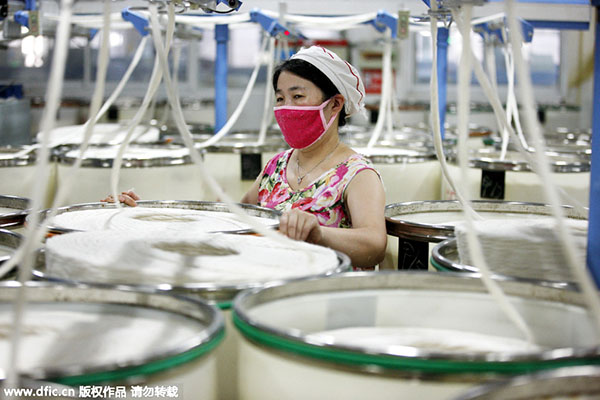China's advantage to avoid 'Japan syndrome'
Updated: 2015-09-15 08:16
By Yao Yang(China Daily)
|
||||||||
 |
|
A female Chinese worker handles production of yarn to be exported at a garment factory in Huaibei city, East China's Anhui province, July 1, 2015. [Photo/IC] |
China seems to be in the same position, economically speaking, that Japan was in the early 1970s. Japan relied heavily on exports to register extraordinary growth in the 1950s and 1960s. But its rapid growth was halted by the 1973 oil crisis, which also had a devastating effect on the world market. During the next decades, Japan's GDP grew 3.4 percent a year, barely 40 percent of the average rate it had achieved in the 20 years before the oil crisis. And when its real estate bubble burst in 1993, Japan's GDP began a long period of virtually zero growth, with its domestic price levels declining secularly.
Analysts often associate the "Japan syndrome" to the country's exports-led growth model and demographic changes. Dependence on exports made Japan vulnerable to the shocks suffered by the world market, because the savings accumulated through exports were the source of its real estate bubbles.
In terms of demographics, Japan's labor supply reached its peak in 1993, after which it started sliding toward an aging society; in fact, it now has the highest proportion of aged people. One of the dire consequences of Japan's aging society is the continuous decline in its domestic demand.
China, too, followed an exports-led growth model for faster economic development. Like the 1973 oil crisis, the 2008 global financial crisis dealt a major blow to the world economy. As a result, China's export-oriented growth has decelerated since. And like in Japan in the late 1980s, the exports-led high rate of savings have contributed to China's real estate and stock market bubbles.
Moreover, China's demographic change is ahead of Japan by 20 years in terms of the two countries' per capita GDP. China's per capita GDP today is equivalent to that of Japan in the early 1970s, but China's labor supply has already begun to decline. In 10 to 15 years, China's baby-boom generation, those born between 1963 and 1976, will exit the labor market. Thus the Chinese economy could suffer the same fate as that of Japan.
However, China has one advantage, though, that is, it has a population 10 times that of Japan and an even larger territory. For one thing, the per capita GDP of China's nine coastal provinces/cities is twice as much as that of the inland provinces. As such, the force of convergence will ensure the inland provinces continue to grow even if the coastal region stops growing.
- China economy enters 'new normal' eyeing 7% growth rate: G20
- China economy under downward pressure: finance minister
- Chinese economy shows 'strong fundamentals', says ex-Australia PM
- Premier confident about economy
- Economy will not see a hard landing: Premier Li
- Don't ignore positive signs of China's economy
- Global health entering new era: WHO chief
- Brazil's planning minister steps aside after recordings revelation
- Vietnam, US adopt joint statement on advancing comprehensive partnership
- European border closures 'inhumane': UN refugee agency
- Japan's foreign minister calls A-bombings extremely regrettable
- Fukushima impact unprecedented for oceans: US expert

 Stars of Lijiang River: Elderly brothers with white beards
Stars of Lijiang River: Elderly brothers with white beards
 Wealthy Chinese children paying money to learn British manners
Wealthy Chinese children paying money to learn British manners
 Military-style wedding: Fighter jets, grooms in dashing uniforms
Military-style wedding: Fighter jets, grooms in dashing uniforms
 Striking photos around the world: May 16 - May 22
Striking photos around the world: May 16 - May 22
 Robots help elderly in nursing home in east China
Robots help elderly in nursing home in east China
 Hanging in the air: Chongqing holds rescue drill
Hanging in the air: Chongqing holds rescue drill
 2.1-ton tofu finishes in two hours in central China
2.1-ton tofu finishes in two hours in central China
 Six things you may not know about Grain Buds
Six things you may not know about Grain Buds
Most Viewed
Editor's Picks

|

|

|

|

|

|
Today's Top News
Liang avoids jail in shooting death
China's finance minister addresses ratings downgrade
Duke alumni visit Chinese Embassy
Marriott unlikely to top Anbang offer for Starwood: Observers
Chinese biopharma debuts on Nasdaq
What ends Jeb Bush's White House hopes
Investigation for Nicolas's campaign
Will US-ASEAN meeting be good for region?
US Weekly

|

|









